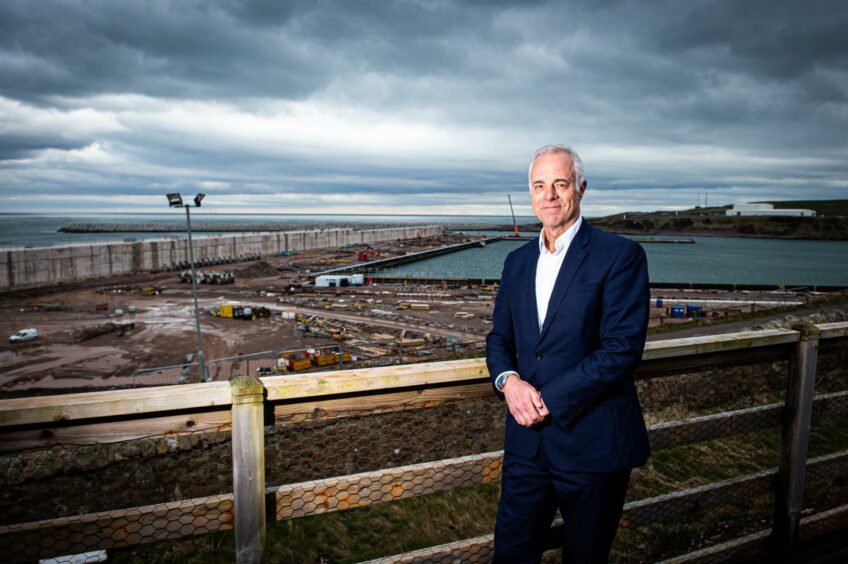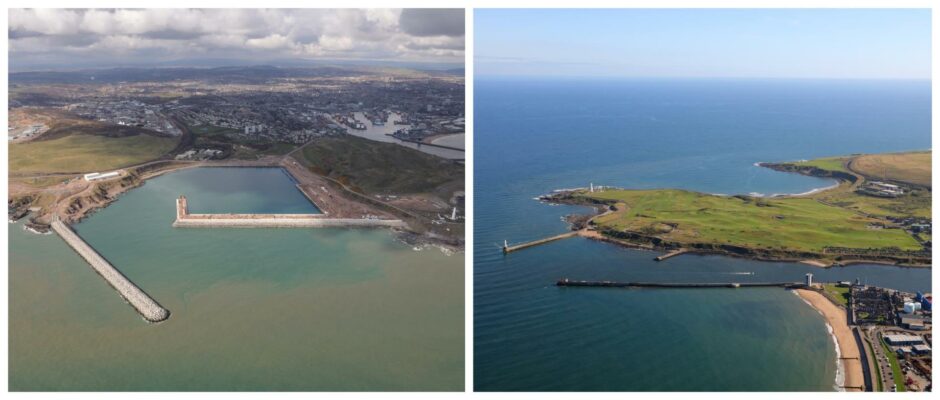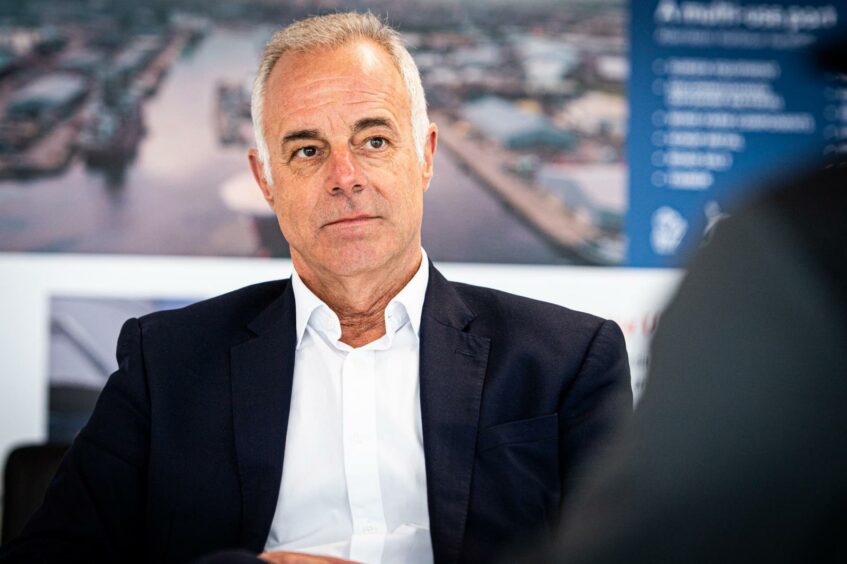 © DCT Media/ Wullie Marr
© DCT Media/ Wullie Marr Aberdeen Harbour Board, the oldest company in the UK, will rebrand later this month as its transformational port expansion project takes shape.
From May 11, the firm will be known as the Port of Aberdeen; a subtle change but one which adds “clarity” to the institution as it gears up for operations at its £400 million expansion project.
Chief executive Bob Sanguinetti said the new name, and new Aberdeen South Harbour, helps showcase a diversified port with energy transition at its heart.
“It more accurately defines what we do,” he said. “A port is a commercial entity, and we are very much a commercial entity. Particularly as we open the South Harbour, and diversify our activity further whilst supporting energy transition.
“A harbour is a safe haven for ships, which clearly we provide, but we do much more than that. We’re a business with commercial imperatives.”
This rebrand to Port of Aberdeen is also to avoid any confusion between the new South Harbour, existing North Harbour or “Aberdeen Harbour” more broadly.
The change will come into effect to coincide with the company’s annual general meeting on May 11, as well as the “soft start” of the first stages of the new harbour expansion.
Although the official operational date is October 31 – which will cover the majority of the project, not the entirety – the first vessels are due to be welcomed in the months ahead.
“The team is doing a fantastic job and we expect the first commercial vessels to be arriving in the summer,” Sanguinetti said.
“Opening a harbour is not the same as opening a motorway when you need to wait for the final metre to be in place before you can use it.
“You can start using elements of the harbour before all of it is ready. And we’re already in advanced discussions with a number of our customers with a view to seeing some activity in the harbour from the second half of the year.”
With the extra space comes a big step up in capacity; the South Harbour will treble the number of deepwater berths available and increase the overall amount of berthage space by around 30%.
Though this reflects a port with a diversified offering, from cruise ships to cargo, eyes are on the “big prize” of the energy transition.
For the coming years, that prize relates to the huge opportunities arising from the recent ScotWind leasing round for offshore wind developments.
The awards in January created a pipeline of projects with 25 gigawatts (GW) of offshore wind capacity. It has been estimated that every GW could generate up to £1bn in supply chain investment, which Aberdeen hopes to play a “fundamental part” in.
No single port can take on the amount of work coming through, Sanguinetti agreed, and there is need for collaboration to see Scotland and wider UK seize the lion’s share of that, lest it go to overseas facilities.
But Aberdeen’s geography, its role as host of “one of the most extensive, if not the most extensive” supply chain and logistics network in the UK for offshore and subsea developments, and proposals for the new Energy Transition Zone (ETZ) just a stone’s throw away, means it has a strong offering to put forward.
“Aberdeen has built up that expertise over 50 years supporting oil and gas. So the emphasis now is continuing to support oil and gas as we go through the transition process into offshore wind and other renewables.
“In terms of where we sit in the supply chain, the wind farms will need to be designed and built, assembled and deployed.
“With South Harbour and the increased capacity that gives us in terms of berthage and laydown area, because this is a very space-hungry sector we’re looking at, you link that with the likes of the nearby ETZ and the wider supply chain, then we’re very well-placed here for high-value manufacturing, engineering and design to take pace in Aberdeen and Aberdeenshire, and then connect the output of that with the windfarms as they’re being built.”
The port can “connect the wet end of the business with the dry end”, as Sanguinetti put it. Assembly and marshalling of the projects, as well as manufacturing of components such as underwater cabling which will connect the huge offshore developments, are some specific examples which Aberdeen can get after.
Another facet of the transition prize which the port aims to focus on is oil and gas decommissioning, as well as the reuse or recycling of equipment.
Sanguinetti said “there is a role for the Port of Aberdeen there in the shorter term” as that activity picks up momentum, and the facility’s location as a gateway for the North Sea oil and gas industry means it is ideally placed to support companies engaged in this sector.
Meanwhile oil and gas will continue to play a vital role in the port’s activities going forward, and cutting emissions within that.
To service its customers, many of whom are themselves part of the energy sector’s supply chain, as well as the wider city, the port hopes to deliver a leading project allowing green shore power for vessels berthed there.
A recent study commissioned by the port showed 78% of emissions from the North Harbour came from its vessels, which the demonstrator could significantly cut into.
Upfront cost is the challenge, and a mix of private and public sector investment is needed to make it a reality – bp recently signed an agreement to help the port deliver projects which could cut emissions.
Sanguinetti highlighted that, with the likely imposition of carbon taxes in time, the financial imperatives for such a project will only grow stronger.
“In the meantime there is a real moral imperative to get on with this,” he added, for the good of the environment and communities local to the harbour.
The significant South Harbour Expansion project will be bolstered even further if the Port of Aberdeen, in its joint bid with Peterhead Port Authority and Aberdeen International Airport, and supported by the local authorities and industry partners, is successful in its bid to become a Green Freeport.
The competition opened in March for two Scottish ports to be given the special status, which offers tax reliefs and other incentives.
Selection would create a more attractive environment for inward investment, as well as positive signals to investors about the region’s role in offshore wind, hydrogen, carbon capture and storage, or other sectors like food and drink and life sciences, argued Sanguinetti.
“A successful bid would signal to potential investors that this is a great place to do business, and encourage them to come and set up innovation hubs and high-value engineering and manufacturing, leading to the creation of highly-skilled jobs and regeneration of local communities.
“In becoming a Green Freeport, you’re also telling the rest of the world that the north-east is consolidating its position as Europe’s leading energy hub, a pivotal role it has played and excelled at over the past 50 years.”
Such a move wouldn’t just benefit the north-east either. The port is a “national asset” and its development will support vital energy transition projects such as the aforementioned offshore wind boom and decommissioning.
The Port of Aberdeen currently employs around 100 people directly, but indirectly supports employment for 12,000 people – a figure which will surge by another 9,000 when the South Harbour reaches its full potential.
Meanwhile, the gross value added for the port is expected to rise to £2.4 billion from £1.5 billion by 2035 and any excess profits are re-injected back into the port.
“Our purpose is to create prosperity in the community for future generations. Every job is linked to a family and a wider network, so what’s good for the Port of Aberdeen is good for the north-east more widely”, said Sanguinetti.
“As an energy port linked to the energy hub that Aberdeen is, I would say that we’re a key, if not critical, piece of national infrastructure that has effect much more widely than Aberdeen and the region itself.”


